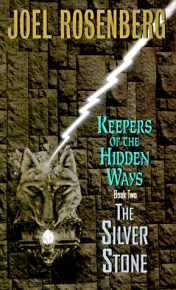

THE SILVER STONEby Joel RosenbergAvon Books0-380-72208-9346pp/$5.99/July 1998 |
 |
Reviewed by Steven H Silver
Joel Rosenberg made his name in fantasy writing the "Guardians of the Flame" series in which a group of college students are magically transported to a magical realm during a role-playing game. After several books in that series and two other series, Rosenberg has returned to that same sub-genre with his "Keepers of the Hidden Ways" series in which college students are transported to a magical realm. The Silver Stone is the second book of the new series and follows Ian Silverstein, Torrie Thorsen and their companions as they return to the mythical land of Tir Na Nog.
While Rosenberg's earlier series was set in a (to star wtih) generic fantasy setting, this new series relies heavily on Norse mythology, including appearances of Odin, Freya, and other standards of the Vikings, although frequently in skewed roles. Unfortunately, this setting does not work as well as the wide variety of lands Rosenberg has invented, whether the world of the Guardians novels or the vaguely Oriental lands of his "D'Shai" series.
Rosenberg uses several viewpoint characters, both the aforementioned college students and the parents and friends of Torrie Thorsen, who hails, ostensibly, from Hardwood, North Dakota (in the Newer World), but really has his roots in Tir Na Nog. Nearly all these characters are representative of the Heinleinian superman (or woman), with the ability to do anything which needs to be done and, perhaps more importantly, the common sense to see what needs doing. Unfortunately, this has a tendency to turn several of Rosenberg's characters more into caricatures.
Perhaps the strongest instance of this is the title character, Ian Silverstein. Throughout this novel and the first book in the series, The Fire Duke, Rosenberg has made it clear that Silverstein was abused as a child. Silverstein escaped from this abuse partly by learning to fence and being able to give fencing lessons. In The Silver Stone, Rosenberg shows Silverstein fencing in excruciating detail, explaining the logic and techniques of fencing each time the character gets into a duel. At one point, Rosenberg even makes a comment about how fencing technique is only of interest to those who fence. As a one-time fencer myself, Rosenberg's repeated descriptions could easily have been trimmed to make those portions of the book less tedious.
The plot places Silverstein on a mission for Harbard the Ferryman to attempt to avert a war. As Silverstein goes about his quest, he comes into contact with the Tyrsons, an almost chivalric order devoted to the god Tyr, who he must convince of the futility of war. Despite Harbard's concerns, Rosenberg shows little sign that a war is brewing. Silverstein also must deal with the belief that he is the "Promised Warrior," a messianic figure and hears vague rumors that assassins are trying to kill him.
Called back from a vacation in Europe, Silverstein's friend Torrie Thorsen chasing into Tir Na Nog after Silverstein, in the company of his girlfriend, Maggie, and his father Thorian Thorsen. They, too, meet up with Harbard, who attempts to divert them from Silverstein's path.
The Silver Stone suffers from being the middle book of a series. The characters have all, for the most part, been introduced in The Fire Duke, and are now being used to set up the final confrontation. As such, The Silver Stone doesn't really come to a conclusion. Furthermore, although Rosenberg showed in The Fire Duke that the forces of Tir Na Nog can have an effect on our world (through a series of werewolf attacks), in The Silver Stone, he doesn't really give the reader a reason to be concerned that the Newer World is in danger. The third novel in the series, The Crimson Sky (Avon Eos, 12/98), apparently does bring the forces of Tir Na Nog into the Newer World when they attack Minneapolis.
Rosenberg has written several interesting and intriguing novels, including his "Guardians", "D'Shai" and "Metzada" sequences. Unfortunately, "The Keepers of the Hidden Ways" series doesn't seem to have the same sense of purpose his earlier works have.
Purchase this book in hardcover from 
Purchase this book in paperback from 